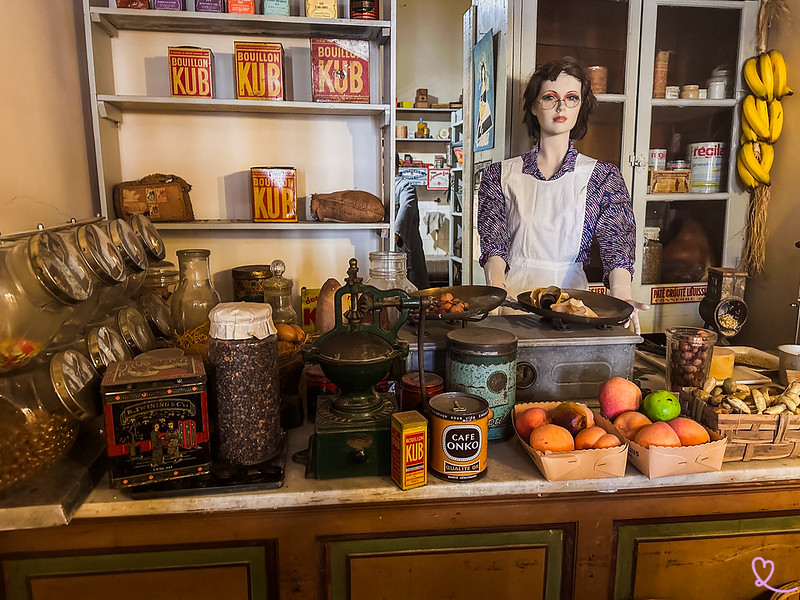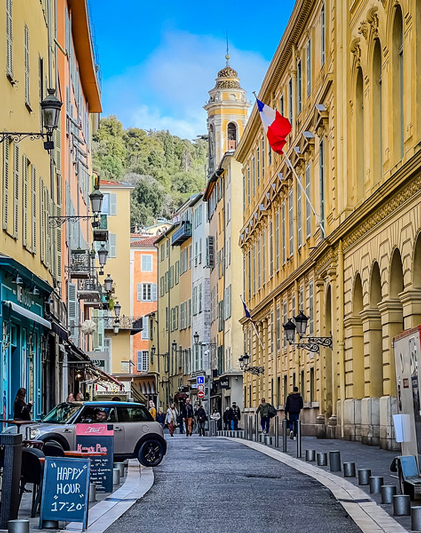Visiting Fréjus or on vacation on the Côte-d’Azur? Soak up Provencal culture at the Fréjus Local History Museum. You’ll discover the different aspects of Fréjus’ social, economic and cultural life in the 19th and 20th centuries.
Here are some useful tips for planning your visit to the Musée d’Histoire de Fréjus en Provence.
BEFORE OUR TIPS + PHOTOS
HERE ARE OUR GOOD PLACES IN Provence

Our favorite car rental platform: DiscoverCars

Our guide to planning your road trip: eBook

Our must-see tour: the abbey of Mont-Saint-Michel – reserve your time

Our unforgettable outdoor activity: Via Ferrata in Suisse Normande

Our favorite places to stay:
Honfleur – see the best rated accommodations
Bayeux – see the best rated accommodations
Cabourg – see the best rated accommodations

This guide is completely independent, based on our experiences. We visited the region anonymously, making our own choices and paying our bills in full.
Is a visit to the Fréjus Local History Museum worthwhile?
Yes, the Fréjus History Museum is well worth a visit! Many visitors flock to the Côte d’Azur for its beaches, climate and breathtaking scenery. But isn’t the real trip the one during which you immerse yourself in the history and culture of the region you’re visiting? Immerse yourself in the history of Fréjus from the 19th century to the present day, and don’t just visit Provence, live it!
We think this museum is one of the best things to do in town! (article coming soon)

What you can see
The “Maria” house
The building in which the museum is housed is the so-called “Maria” house. We discovered that it’s an old bourgeois house dating back to the 16th century.
Keep your eyes peeled! We enjoyed exploring the various rooms, even though they were renovated in the 19th century.

In this house, you can discover:
- a kitchen with a monolithic stone sink
- a vast fireplace with open mantel
- a reception room
- a beautiful multi-level stairwell
- We also loved the garden

The Museum will introduce you to the first French Naval Air Station. It was built in Fréjus in 1911. We discovered that it was from this base that Roland Garros set off on his Mediterranean crossing on September 23, 1913. Costumes of aviators and naval aviators allowed us to project ourselves into the world of aeronautics.

We enjoyed hearing the story of this place steeped in history. In fact, a leisure and nature area has been created on the site. It’s one of the best things to do in Fréjus! (article coming soon)
A tribute to the Malpasset dam disaster
If we hadn’t visited this museum, we’d never have known that a dam devastated Fréjus, killing several hundred people in 1959. This is the Malpasset dam. On December 2, 1959, at 9:10 pm, it gave way and spilled 50 million cubic meters of water over the city.

We were moved to learn that this disaster was one of the worst of the 30 Glorieuses. We found that this event had a profound effect on the history of Fréjus. Find out more in the museum, with photos, testimonials and diagrams on display.

A traditional Provencal reception room
We really enjoyed discovering the reception room. Here you’ll discover a collection of authentic Provencal headdresses and costumes from the late 19th and 20th centuries. Thanks to this exhibition, we now know how to distinguish the dress of a craftswoman from that of a bastidane – a wealthy landowner. You can also see fabrics and headdresses.

Before leaving the room, take a look at the painting of Fréjus in the late 17th century. We found it very interesting to observe the arrival of the Roman aqueduct on the outskirts of the city and the silhouette of the cathedral bell tower. As you leave the museum, you’ll see the city through a different set of eyes.

The veranda and garden of the house
The visit revealed that agriculture was the town’s main economic activity until the early 20th century. In the garden, you’ll discover many of the tools used to work vines, reeds and fruit trees such as peaches.

Don’t forget to browse the bottom of the garden. We discovered wine presses evoking Fréjus’ winemaking activity and a reconstruction of the workshop of the town’s last blacksmith!

The history of Fréjus ceramics
Did you know that Fréjus has been a major ceramics producer since Roman times? Throughout the exhibition, we admired works from workshops in Biot, Vallauris and Fréjus. We loved the colorful hues of some of the pieces.

One room is devoted to the ceramist Dominique Zumbo, whose work we really enjoyed. We found it very original, evoking Art Nouveau, with its metallic shimmering pieces.
The reconstruction of a school under the 3rd Republic
We took a trip back in time, discovering the reconstruction of an early 20th century school. You’ll see desks and inkwells, the sawdust stove at the back of the classroom, maps and measuring instruments, and the teacher’s platform. All typical elements of a school under the 3rd French Republic.

A grocery store from the 1930s
We were surprised to find a reconstructed grocery store in the museum! It was when we wanted to find out more that we realized why this business had a place in the exhibition. In fact, you’ll discover that in the 1930s and 1940s there were plenty of grocery stores in town.

As the objects and foodstuffs on display show, the grocery store offered both
food, hardware and drugstore products. This part of the museum made us aware that consumer practices have changed considerably since the second half of the 20th century.

The Forum Lulii mint
Forum Lulii… what could it mean? It’s the former name of the town of Fréjus!
Forum Lulii’s currency is therefore the city’s ancient motto.

We found it fascinating to observe these coins minted in Fréjus in 28-27 B.C. 2000 years of history right before your eyes!
If you look closely, you’ll see Capricorn surmounting a globe and the armed prow of a ship.
Local History Museum in Fréjus: access
Where is the Fréjus Museum?
- The museum is located in the center of Fréjus
- It’s a 30-minute walk from Fréjus beach and a 10-minute walk from the train station.

Access by car and parking
There are a few parking spaces in the street around the museum, but in high season, finding a free space can be a miracle. The nearest parking lot is Parking Paul Vernet, just a 3-minute walk from the museum. It is located at 115 Place Paul Vernet in Fréjus.
We advise you to park as soon as possible, as summer traffic in town can be complicated.

OUR TPS FOR RENTING YOUR CAR IN Provence
- Compare prices on our preferred platform: DiscoverCars – one of the best rated sites.
- Choose a car that is powerful enough (the roads are steep) but compact (some passages are narrow).
- Think of thecomplete insurance (some roads are tortuous and narrow).
- There is a lot of demand, book it early.

Public transport access
The museum is easily accessible on foot or by bike.
You can also opt for a bus trip. The Musée d’Histoire Locale de Fréjus is served by the 01, A and C bus routes of the local transport network.
To plan your itinerary, we invite you to consult the official website of the public transport networkhere.

Visiting difficulties
The museum is on 3 floors with no elevator, and there are also a few steps down to the garden.
The site is not accessible to people with reduced mobility.

PLAN YOUR STAY IN Saint-Raphaël

Useful tips for visiting the Fréjus History Museum
Schedules and prices
Museum opening times are as follows:
- October 1 to March 31: Tuesday to Saturday, 09:30 to 12:00 and 14:00 to 16:30.
- April 1 to September 30: Tuesday to Sunday, 09:30 to 12:30 and 14:00 to 18:00.
Admission is €3.
See the latest information on the official website here.

How long
We recommend that you allow between 1h and 1h30 for a visit to the museum, depending on your interest in the various objects and the history of Provence.
Best moment
To avoid the summer crowds, it’s best to visit out of season. It’s also a great way to escape the summer heat.

Direction of visit
The tour covers 3 floors. The museum isn’t huge, so you won’t get lost, and we found the route easy to follow.
Here are the different areas to visit:
- Entrance hall and corridor: Forum Iulii coinage & tribute to the Malpasset dam disaster
- Veranda and garden: wine-making utensils and a reminder of the public washhouse
- 1st floor: evocation of the Bravade, reception room and traditional Provencal costumes.
- 2nd floor: history of ceramics in Fréjus, reconstruction of a 1930s grocery store and a school under the 3rd French Republic
- 3rd floor: history of the Fréjus Naval Air Station

Eating out
The museum is right in the center of town, and there are many fine restaurants nearby, such as La Brasserie Le Palais (1min walk) and Crêperie l’Évidence (2min walk). To find out more, read our article on the best restaurants in Fréjus and Saint-Raphaël (coming soon)!
Hotels
Fréjus is an ideal place to spend the night, close to Cannes and Sainte-Maxime. Fréjus and Saint-Raphaël border each other, so here are our recommendations for staying in the area:
WHERE TO STAY IN Saint-Raphaël
Option 1 : downtown and beaches of Saint-Raphaël and Fréjus
Enjoy the charm of the towns and all the restaurants.
We recommend..:
- Hotel Unique – see prices, photos and availability
- Hotel Le Touring – prices, pictures and availability

Option 2: Along the coast to Esterel
By the sea, luxury hotels near the red rocks of the Esterel. We recommend..:
- Hotel La Villa Mauresque – prices, pictures and availability
- Hotel Les Roches Rouges – prices, pictures and availability

Option 3: in the countryside
For more peace and quiet, enjoy the sea or the countryside, but still close enough to the city. We recommend..:
- Hotel Le Confidentiel – prices, pictures and availability
- Hotel la Bastide du Clos des Roses – see prices, pictures and availability

PLAN YOUR TRIP TO provence
Our articles are coming!
- Most beautiful cities in Provence (coming soon)
- Most beautiful beaches of Provence (coming soon)
- Most beautiful villages of Provence (to come)
- Most beautiful destinations in Provence (coming soon)



